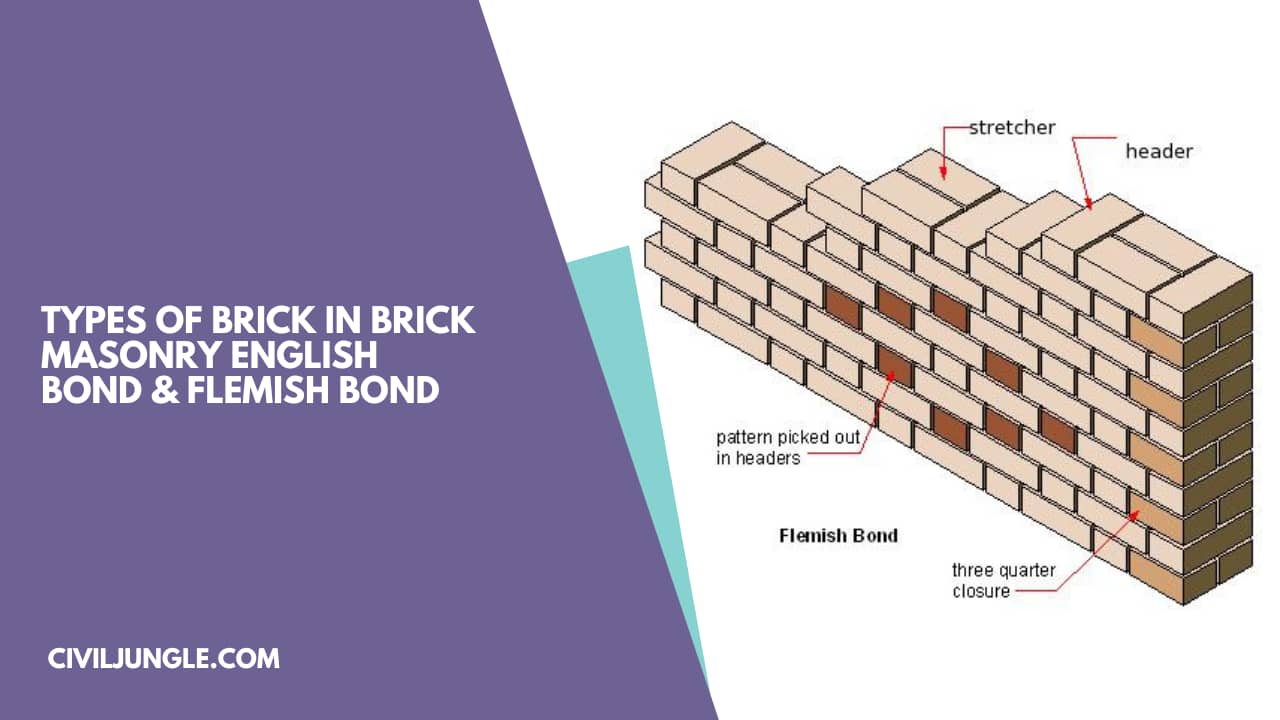
Introduction of English Bond & Flemish Bond
Important Point
Various types of bonds in brick masonry used for wall construction are classified depends on bonding style and laying of bricks in walls.
The bond pattern used in brick masonry is developed by the mortar filling between two layers of bricks and in grooves when bricks are laid adjoining to each other on layers in walls.
What Is an English Bond?
This English bond used in brick masonry, it has only one course of stretcher and course of header just above it, i.e., it has two alternating courses of headers and stretchers.
In this bond, Headers are laid in the middle on the stretchers in course under, and each alternate row is perpendicularly associated. To change the pattern or To break the link of vertical joints, quoin closer is used in the starting and end of a wall just after the first header.
The quoin close is a part of a brick cut down lengthwise into two similar halves and used in corners area in brick walls.
The Basic Concepts of English Bond
Stretchers and Headers are laid in interchange courses. This is one of the Strongest types of bonds. It will Provide a rough appearance on the surface.
In its presentation, you will find the structure without vertical joints in brick masonry. During the construction of this bond, it does not require any individual attention.
Work done in between the given time is more compared to another bond. It is beat Costly in compare to others; brickbats are used in a rare case.
For the construction of this bond, no Skilled labor required. Less mortar is used for this bond.
Also, read: Test for Compressive Strength of Brick | Water Absorption | Dimensions Test
What Is Flemish Bond?
When it is necessary to divert patterns of connection or for the changing of vertical joints in the following courses in brick masonry, closers are inserted in interchange courses just next to the quoin header.
Some times in walls construction, walls having their thickness similar to the odd number of half bricks, bats are effectively used to complete the bond.
This Flemish bond, also well-known as Dutch bond, is created by laying alternating stretchers and headers in a single course.
The next course of brick is arranged in such a way that the header lies in the center of the stretcher in the course below, i.e., the alternate headers of each course are in the middle of the stretcher, of course, set below it.
In this types of bond, every alternative course of this Flemish bond starts with a header at the corner.
Only in one case, the thickness of the Flemish bond is lowest in full brick.
The demerits of using this Flemish bond are that construction of Flemish bond is complex and requires higher expertise to lay it on proper place as all vertical mortar joints need to be associated vertically for best bonding effects.
For the changing pattern or breaking of vertical joints in the successive courses, closers are inserted in alternating courses next to the quoin header.
In walls having their thickness similar to an odd number of half bricks, bats are acceptable for getting the best bonding.
The Flemish bonds have a better outward show. However, they are weaker than English bonds for load-bearing in wall construction.
Hence, if the pointing has to be done for brick masonry in wall construction, then the Flemish bond may be used for a better aesthetic outlook.
When the walls have to be plastered, English bond is the best choice for it.
Also, read: Trapezoidal Footing Formula with Calculation
Flemish Bonds Are Classified As:
- Single Flemish Bond.
- Double Flemish Bond.
#1. Single Flemish Bond:
Single Flemish bond is a mixture of Flemish and English bond. During this types of construction, the face exposed surface of the wall consists of the Flemish bond and the backside surface of the wall made of by English bond in each course.
The smallest thickness essential for a single Flemish bond is one and a half brick thickness.
The major point of using a single Flemish bond is to offer higher aesthetic looks on the front side of the wall surface with required strength in the brickwork by using an English bond.
#2. Double Flemish Bond:
The Double Flemish Bond has a similar appearance from both sides of the face in the front and back elevations, i.e., in each course, it consists of alternating stretcher and header.
This type of bonding is somewhat weaker than the English bond.
Also, read: Rate Analysis of Brick Masonry
Basic Concept of Flemish Bond
In this bond, stretchers and Headers are laid alternately in each course. If the thickness of the wall more than 30cm, than this bond is Comparatively less strong.
It provides a good appearance. In this bond, Partly incessant vertical joints appear in the structure. It needs Special concentration is essential for this bond. It’s beat hard to build. Hence Progress of work is less.
Very acceptable due to it is Economical, as brickbats are used, on another hand More mortar is used due to the use of bats.due to a complex arrangement of pattern, Skilled labor required for the construction of this bond.
English Bond
English bond (plural English bonds) (masonry) In bricklaying, an arrangement of bricks such that one course has the short sides of the bricks (headers) facing outwards, and the next course has the long sides of the bricks (stretchers) facing outward.
Flemish Bond and English Bond
English bond and flemish bond are as follows: English bond is much stronger than flemish bond for the walls thicker more than 1½ brick. Flemish bond is economical as it uses broken brick bats, although it requires some extra mortar for additional joints.
Flemish Bond
Flemish bond (plural Flemish bonds) (masonry) In bricklaying, an arrangement of bricks such that each course consists of alternate bricks having their short sides (headers) and long sides (stretchers) facing outwards, with alternate courses being offset.
Flemish Bond in Brick Masonry
Flemish bond, also known as Dutch bond, is created by laying alternate headers and stretchers in a single course. The next course of brick is laid such that header lies in the middle of the stretcher in the course below, i.e. the alternate headers of each course are centered on the stretcher of course below.
Flemish Bond
a masonry bond in which each course consists of headers and stretchers alternately so laid as to always break joints.
English Bond Brick
English bond (plural English bonds) (masonry) In bricklaying, an arrangement of bricks such that one course has the short sides of the bricks (headers) facing outwards, and the next course has the long sides of the bricks (stretchers) facing outwards.
English Bond Brickwork
English bond brickwork combines alternate courses of stretchers and headers. This traditional pattern is considered to be one of the strongest bonds and is commonly used for bridges and engineering projects. It requires more facing bricks than other patterns.
Single Flemish Bond
A single flemish bond comprises the double flemish bond on its facing and English bond as backing with hearting in each course. Hence, the bond makes use of the strength of both English and Flemish bond. This bond can be used for the construction of walls with a thickness not less than one and a half brick.
English Bond in Brick Masonry
English bond is a pattern formed by laying alternate courses of stretchers and headers. The joins between the stretchers are centred on the headers in the course below. This is one of the strongest bonds but requires more facing bricks than other bonds.
Difference Between English Bond and Flemish Bond
A brick construction pattern with alternate courses of brick laid as stretchers and headers forms an English bond. A flemish bond is a brick construction pattern that consists of alternate stretchers and headers for each course.
What Is English Bond?
In English bond, the stretcher courses consist of bricks laid with their long sides facing outwards, creating a row of bricks that primarily show their stretchers (long sides). The header courses, on the other hand, consist of bricks laid with their short ends facing outwards, resulting in a row of bricks where the headers (short ends) are predominantly visible. The headers are positioned in the middle of the stretcher courses, directly above and below each other.
English Bond Wall
English bond consists of courses of stretchers (sides of bricks) alternating with courses of headers (ends of bricks) throughout a wall surface.
Double Flemish Bond in Brick Masonry
Double Flemish Bond has the same appearance both in the front and back elevations, i.e. each course consists of alternate header and stretcher. This type of bonding is comparatively weaker than English bond.
Types of Brick Bonds
- Stretcher Bond: All bricks laid as stretchers.
- Header Bond: All bricks laid as headers.
- Flemish Bond: Alternating pattern of stretchers and headers within each course.
- English Bond: Alternating courses of stretchers and headers.
- Monk Bond: Two stretchers followed by one header in each course.
What Is English Bond and Flemish Bond?
A brick construction pattern with alternate courses of brick laid as stretchers and headers forms an English bond. A flemish bond is a brick construction pattern that consists of alternate stretchers and headers for each course. Also Read: Types of Bonds in Brick Masonry Construction.
One Brick Wall in English Bond
English Bond
English bond in brick masonry has one course of stretcher only and a course of header above it, i.e. it has two alternating courses of stretchers and headers. Headers are laid centered on the stretchers in course below and each alternate row is vertically aligned.
Where Is Flemish Bond Used?
The main purpose of using single Flemish bond is to provide greater aesthetic appearance on the front surface with required strength in the brickwork with English bond. Double Flemish Bond has the same appearance both in the front and back elevations, i.e. each course consists of alternate header and stretcher.
Like this post? Share it with your friends!
Suggested Read –
- Stretcher Bond
- What Is Transit Theodolite | Theodolite Parts
- What Is Traversing in Surveying | Types | Method | Definition
- 14 Difference Between One Way Slab and Two Way Slab | What is Slab
- First Angle Projection & Third Angle Projection Symbol (Orthographic Projection)
- What Is Lap Length | Lap Length of Column | Lap Length of Slab | Lap Length of Beam
Originally posted 2023-06-22 12:30:14.
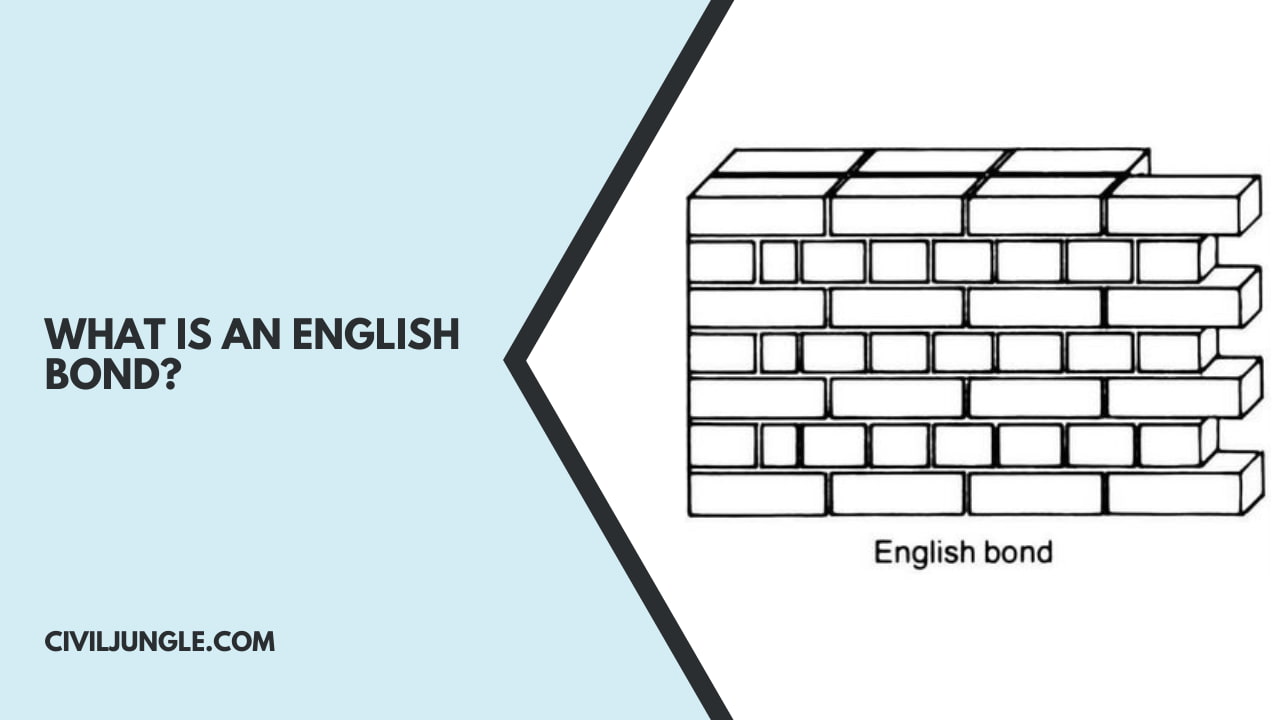


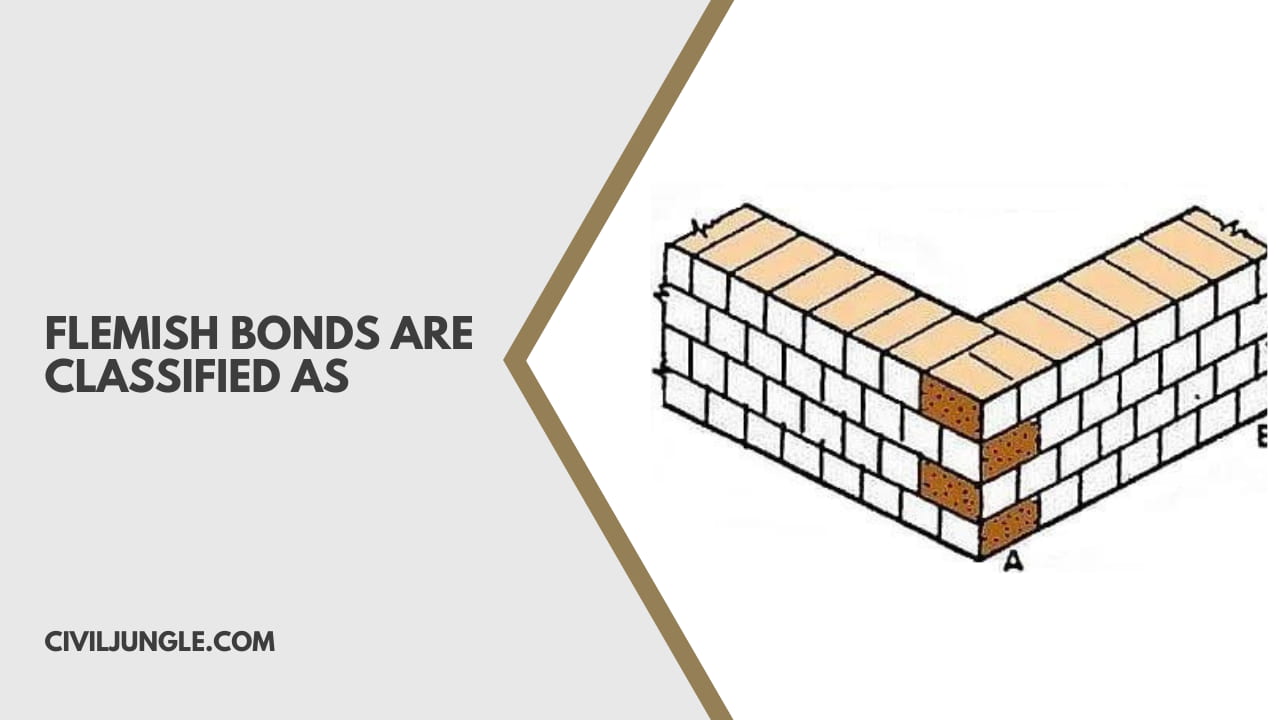
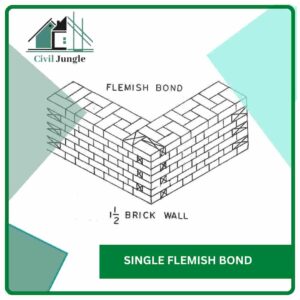
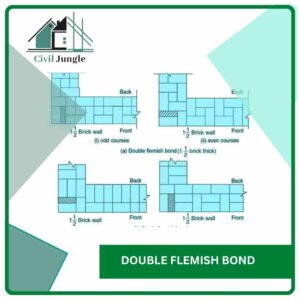
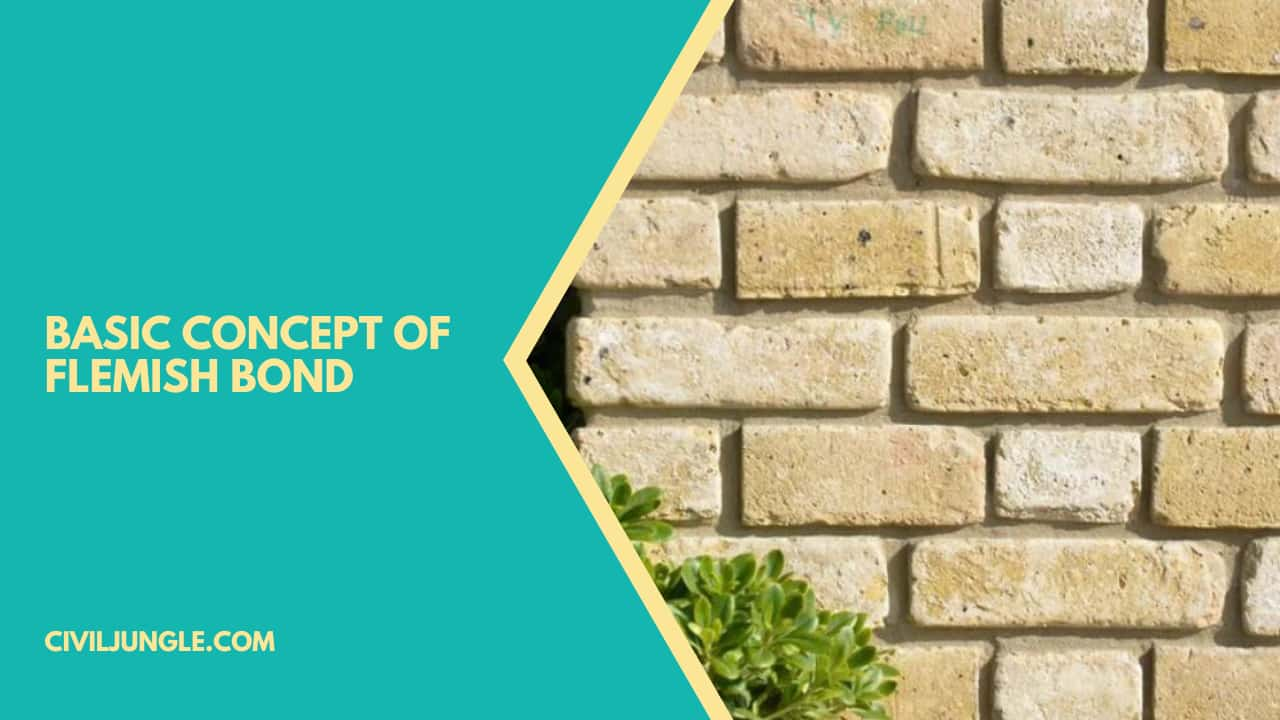

Leave a Reply